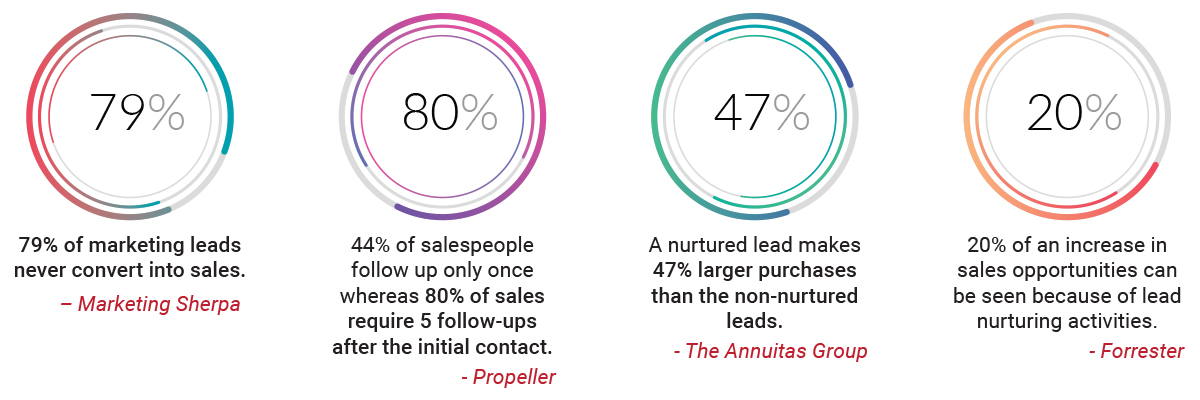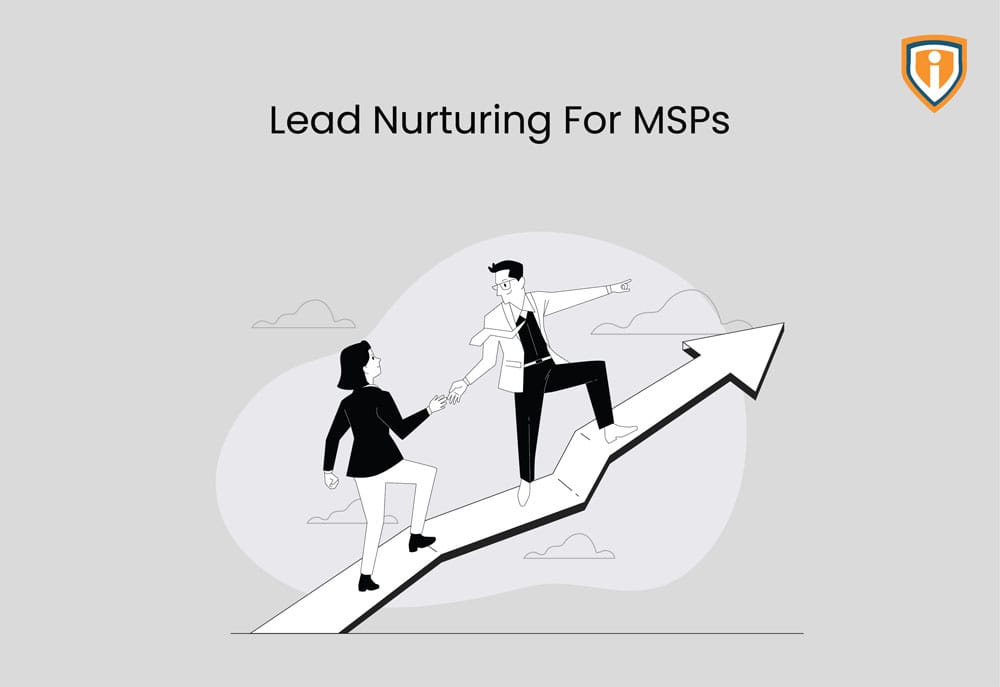Lead Nurturing –an Introduction
Do you reach out to a lot of leads but very few of them convert to sales? Do you feel your efforts go in vain? Many businesses feel that generating leads and convincing them is all there is, followed by the closure of the sale. Many often miss the main attribute in the sales cycle which is Lead Nurturing. This blog post is entitled to provide you with the knowledge you need in order to nurture your prospects/leads. In simpler terms, Lead Nurturing is staying in touch with your prospective clients or your leads throughout the buyers’ purchase stages.
Lead Nurturing your prospects encompasses making them aware of the services you provide, the problems that are prevalent in the industry and the solutions you can provide. From getting in contact with them for the first time to the purchase stage and even the post-purchase stage, Lead Nurturing is being in constant contact with your leads.
You can nurture leads through Marketing messages– sent to those who have already shown an interest in your company. It can be in the form of Cold calling, e-mails, blogs, chat messages, social media platforms etc. Equip them with the necessary knowledge and guide them through your marketing messages.
The goal of lead nurturing is to increase your company’s’ brand awareness, thereby increasing your sales opportunities. A properly strategized and laid out lead nurturing plan helps you convert those prospects into paying customers and helps strengthen the sales funnel.
A Marketo report states that 50% of leads will never be ready to make a purchase. To convince that 50% to buy your product, you need to nurture them.
Let’s dive into some strategies to help you nurture your leads.
The 3-step process:
Lead Nurturing is a minor yet highly significant part of the entire sales journey.
It can be further sub-divided into 3 stages: Awareness, Engage & Enlighten, Value Addition
Awareness- Generate awareness regarding your company and the products and services you provide. After a brief introduction during the first call and the first follow-up, the lead might be interested in knowing more about you and your company in detail. This initial introduction phase is the “Awareness” stage. Send them collaterals of e-books, service brochures, blog links, website links etc.
Engage & Enlighten– Engage them in a conversation, keep the conversation light–hearted, be concise and clear and keep them hooked. Enlighten them about the problems they might face, the services you provide and how you can help them solve their problems. Knowing the pain points of your leads will help you understand their problems better. Content like case studies, videos etc. will seem more convincing and appealing to the leads.
Value Addition– Add value to your leads by providing them with data and statistics or knowledge that they were otherwise unaware of. This can be done via e-books, whitepapers, blog articles etc.
Here are some Lead Nurturing statistics–

The stats are hard to ignore. If you are a company that has many clients and you do not have a big enough team to e-mail or follow up with every prospective lead, the one tool that will help you stay in touch is e-mail automation.
How to nurture your leads? 5 effective Lead Nurturing Strategies.
Here’s a list of 5 Lead Nurturing strategies, which will help you curate your Lead Nurturing campaign, effectively.
1. Regular e-mails:
A thread of e-mails that you send to you customers should take your leads through your company journey. Talk about your beginning, your vision and mission, your customers, links to case studies and blogs etc. Tip: To retain your existing customers, you can send links of the latest blog or a case study. Sharing these with your existing customers would not only benefit them but your company as well.
E-mail Automation is always a good choice but in case you haven’t automated your e-mails and you still send out e-mails manually, make sure you:
2. Personalize:
Address the person you are e-mailing to by referring to them by their first name. When you reach out to a prospect via call, address them by their name, which adds a personal touch. It also creates a positive impact. Although geography plays a major role here too. It all depends on where your clients are from and their personal preference. Ideally, it is recommended to address people by prefixes like Mr/Mrs/Miss and if they do permit you to address them by their name, then do so.
3. Add Value:
One of the steps we discussed earlier, was Enlighten, you need to enlighten and educate your customers by sending them e-mails that have information that could be helpful and valuable to them.
Each interaction you have with your lead should have a purpose and a Call-to-Action (CTA) in the end.
4. Call them up:
It’s easy to get carried away with nurturing your leads through e-mails. But there’s nothing better than calling your leads and engaging them in a casual yet productive call. Talking to your lead on call helps establish a layer of trust. The confidence in your voice, the casual conversation that help builds rapport are all little things that can make a significant difference. Who knows, after the call, your lead might reconsider his decision and start a partnership.
5. Social Media:
Yes, you read that right. Most IT companies negate Social Media from their campaigns but that is an underestimation. An active presence on Social Media and sharing personal stories on these accounts can lead to building trust. Not only that, it helps generate awareness, helps enlighten and educate and add value to their feeds. Social media is where you can take the liberty to not only add value to your clients but also add a personal touch.
How often should you contact your leads?
There’s a difference between keeping in touch with your leads and pestering them with marketing messages. No one likes repetitive sales calls, messages or e-mails that irritate, especially when there are numerous other salespeople vying for attention. Figuring out the right amount of contact for a new lead can vary for different leads.
But if you don’t put out marketing messages at the right time, chances are that your leads will forget that a company like yours exists. And that is why it is crucial for you to leave a mark on your prospects’ mind, in the very first few conversations.
The biggest drawback of outbound lead generation is that you contact your customers not when they “need” it but when you “need” it. So, customers would listen to you if they are in the need of it. Striking the right chord at the right time is the deciding factor here.
But how often is ‘too often’?
Well, there is no pre-defined “number” that exists but you can judge the persons’ interest by their interest in what you have to say.
- Do they divert the topic or stick to the topic?
- Are they eager to hear you out on what your company does and what you have to offer or are they just beating around the bush?
- Do they put off the call for a later time and avoid discussion by postponing, repeatedly?
- Do they read your e-mail/messages and not respond, always?
The interest and eagerness indicated from their side will give the answer to “How often should you contact your leads?”
When to stop following-up?
The interest level of the clients has the answer
Not all leads are worth nurturing. Client interest levels are determined by their behaviour and response towards the interaction. The experience will help you pre-qualify the extent to which a prospect should be chased. It will help determine the effort that should go into converting the sale.
Clearly not Interested- When the person tells you the very first time that he is not interested, he/she is not a lead, so better not contact them. Well, most of them would never buy but some of these just need to be nurtured more. Even if they don’t buy, they will recommend your company to someone else based on the positive experience they have had with you.
Partially interested– For example, let’s say that a prospect has said that he/she might have something in store for you after 3 months. Do contact them at that time to talk business. Make sure you keep in touch with them through calls or e-mails or messages even prior to that. This acts as a reinforcement and when you contact them later, there are high chances of conversion.
Interested– The people who eagerly listen to you and have told you that this is something that they are looking forward to, then that is a green signal. If you get in touch with people like these, then make sure you follow up diligently. If they are interested, it just makes things easy for you, convincing them becomes easy.
Interested but call me later– You’ll come across people who are actually interested but are not free to talk, they need you to contact them at a later time. Ask them for their availability and reach out to them soon.
Lead Nurturing Best Practices
- Do not contact your leads every day
- Personalize e-mails by addressing your clients by their first name- adds a personalized touch
- E-mail segmentation– every e-mail is not suitable for every prospect
- Ask for feedback
- E-mail is not the only way to contact your leads, call them
The end goal of lead nurturing is to trigger a positive reaction or take your company into consideration when they need it. Employ these strategies and best practices and there are high chances for you to convert your lead into a customer.
And if you’re experiencing customer churn; here are some strategies that will help you retain your existing customers.
Upcoming
We keep uploading new blogs quite frequently on our website- keep an eye out for those.
Lastly, if you need help with more such IT Solutions, feel free to reach out to us. We’ll be happy to resolve your queries.





